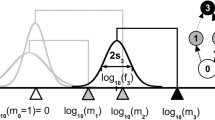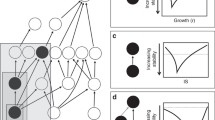Abstract
The study of food webs has long been a central topic of ecological research, but the structural effects of trophic level on their stability are still not clear. The work described here addresses the influence of a restriction arising from the trophic level on the network topology of food webs which affects their global behavior. We propose a network model of food webs in which the degree of the effects of the trophic level on speciation can be adjusted continuously by a single parameter. The restriction limits the number of species at each level and the establishment of prey-predator relationships between distant levels. Experimental results show that the restriction contributes to the stability of the ecosystem. This is because the strong restriction keeps less robust species at the lower levels abundant by making the distribution of the number of species at each level flat, while the distribution became an inverse pyramidal structure without the restriction. On the other hand, we found that several features of the network, such as the power-law distribution of coextinction sizes and the number of predators, do not depend on the degree of restriction. We also show several comparisons of the experimental data with empirical data in the fossil records.
Similar content being viewed by others
Explore related subjects
Discover the latest articles, news and stories from top researchers in related subjects.References
Amaral LAN, Meyer M (1999) Environmental changes, coextinction, and patterns in the fossil record. Phys Rev Lett 82:652–655
Camacho J, Solé RV (2000) Extinction and taxonomy in a trophic model of coevolution. Phys Rev E 62:1119–1123
Drossel B (1998) Extinction events and species lifetimes in a simple ecological model. Phys Rev Lett 81:5011–5014
Pekalski A (2008) Extinction risk and structure of a food web model. Phys Rev E 77:031917 (8 pp)
Lassin M, Bastolla U, Manrubia SC, et al (2001) Shape of ecological networks. Phys Rev Lett 86:4418–4421
Newman MEJ, Palmer RG (2003) Modeling extinction. Oxford University Press, Oxford
Barabási AL, Albert R (1998) Emergence of scaling in random networks. Science 286:509–512
Sepkosk JJ Jr (1992) A compendium of fossil marine animal families, 2nd edn. Milwaukee Public Museum Contributions to Biology and Geology, vol 83, pp 1–156
Author information
Authors and Affiliations
Corresponding author
Additional information
This work was presented in part at the 14th International Symposium on Artificial Life and Robotics, Oita, Japan, February 5–7, 2009
About this article
Cite this article
Ochiai, H., Suzuki, R. & Arita, T. The effects of the trophic level on the stability of food webs. Artif Life Robotics 14, 379–383 (2009). https://doi.org/10.1007/s10015-009-0689-7
Received:
Accepted:
Published:
Issue Date:
DOI: https://doi.org/10.1007/s10015-009-0689-7




